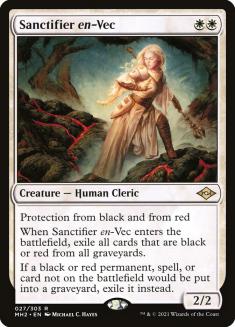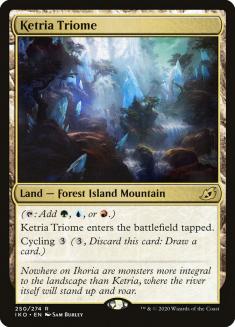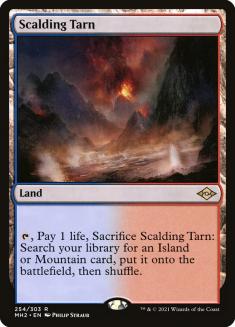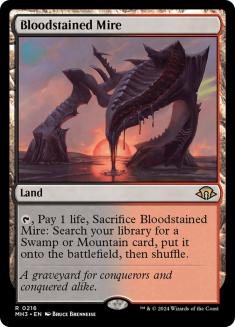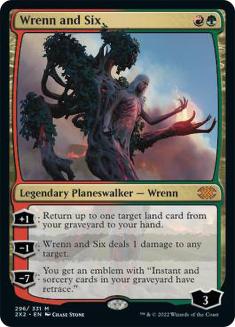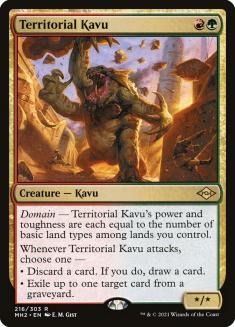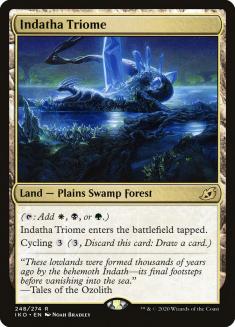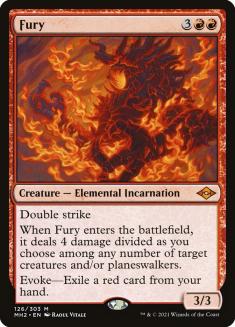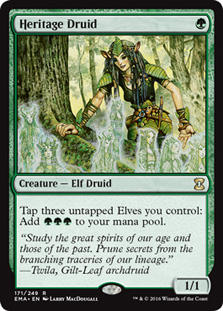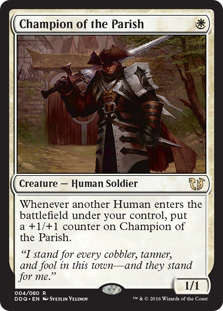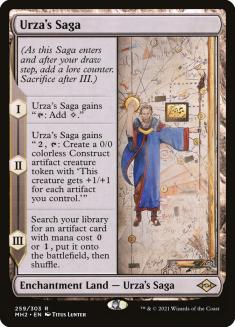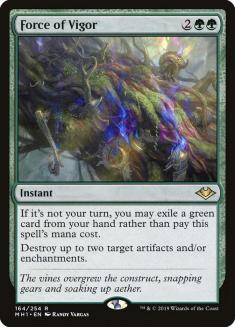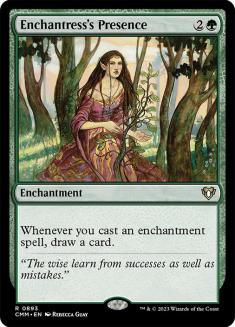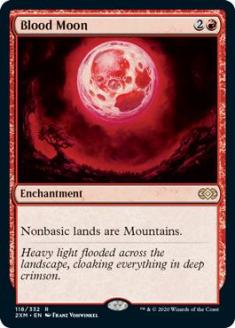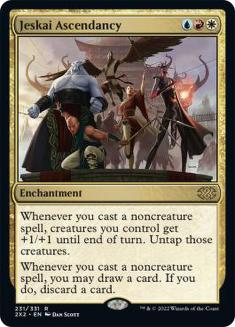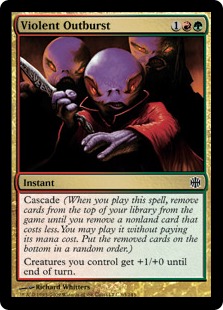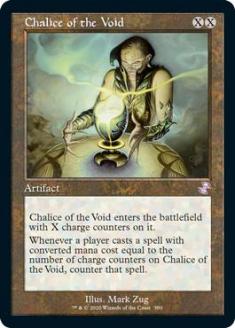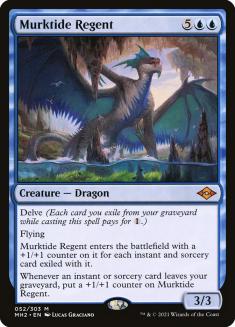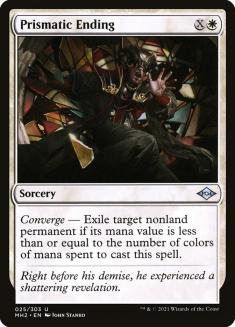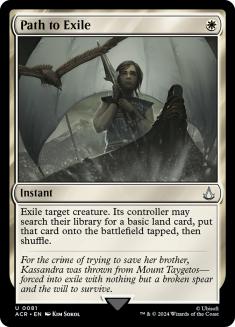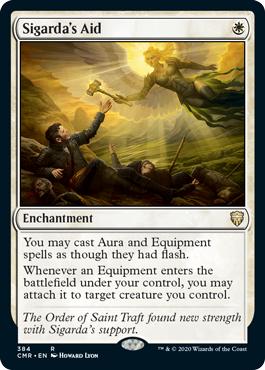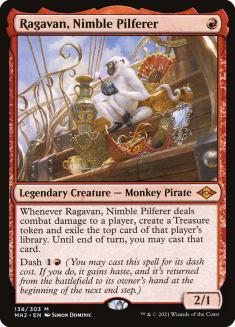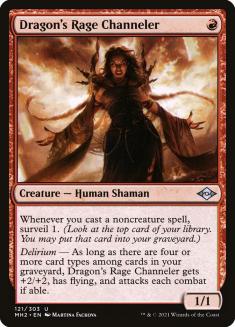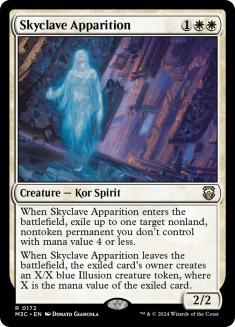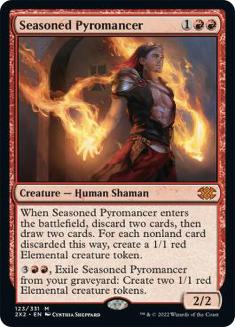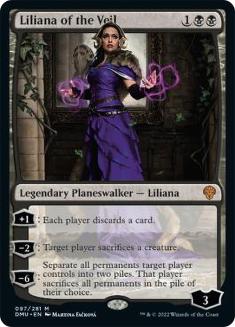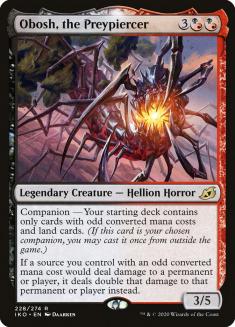Modern is in a great place yet again. We’ve reached the point of Modern Horizons 2 era where the format is stable enough to start trying things, and quite a few of those things seem to work every week.
But all of that is constrained. More than ever, the best cards in Modern are absurdly good, and you need to have a plan to address the cards that define the format.
This list is the cards that define the limits of Modern. The things that the format supports as consistent and functional, the threats you have to address to compete in games, and the answers that are hard checks on certain angles of attack. Whenever you think about making a new deck decision, you have to respect these ten cards and what they do to the rest of the format.
Honorable Mention: Sanctifier En-Vec
Is it even a Top 10 list if you don’t cheat and add the 11th place as an Honorable Mention?
Sanctifier En-Vec doesn’t quite make the list because it’s so easy to play Modern and completely forget it exists. You check the price of Ragavan, Nimble Pilferer, nod a bit, and say something like “maybe next Christmas” before playing a different deck and Sanctifier doesn’t impact your life.
But if you have tried to play any Rakdos-centric deck in Modern, you know the nightmare that is Sanctifier En-Vec. The overlap of “I can barely kill this card the first time they cast it” with “even if I’m a fair deck this is going to blank a noticeable percentage of my deck” is a problem, and I’ve yet to find a deck that solves it.
At least, I’ve yet to find a deck that solves that issue in context of Mono-White Hammer (Lurrus) being the most common deck presenting Sanctifier En-Vec as a threat. You could probably beat some mono-white pile with Sanctifier since none of their other cards matter, but the fact it just shows up as the cherry on top of one of the best decks in the format that already presents a ton of other issues and can freely recast Sanctifier off Lurrus of the Dream-Den is a bit too much to handle.
As soon as you think about having a nice little time with Rakdos, Mardu, Grixis, or Jund, you’ll find yourself remembering Sanctifier exists real fast followed by wanting to play a different deck. It’s rare to see a hate card that’s this effective against “fair” decks.
10. Ketria Triome (and the rest of them too)
Let’s get an elephant out of the room.
The fetchlands aren’t on this list. They are the champions emeritus of any Modern card rankings. They’re so important, they loop back to unimportant because building a deck without them is an exception to the rule.
Triomes represent a change to the standardized fetchland manabase. Back in the first five years of Modern, you only had the enemy color fetchlands and allied trio manabases had some weird constraints about painless sources of the center color and you had things like no basic Mountains in Jund. Then we got the allied color fetches in Khans of Tarkir and three-color mana was completely free.
But the fourth color was still a pain, literally. With the Triomes, playing four colors is the old playing three colors. With an end of turn fetch, you get to “spend the mana” of a Triome entering the battlefield tapped at your convenience, and once you have a Triome you can basically assemble any two or three other lands you want and just cast the spells in a four-color combination.
You probably associate this with the Omnath, Locus of Creation decks right now, but I expect a lot of progress over the next few years in this sector of the metagame. Black won’t be the worst color in Modern forever and there’s a lot of “name that Nephilim” to play with the other color combinations.
The Triomes’ impact goes even deeper, since the fifth color can also be free if you just a sprinkle of it. Territorial Kavu and full five on Prismatic Ending are the most common, but we could go back to 2019 and get busy with some Niv-Mizzet Reborn action. Since you have access to every color, it’s literally inevitable that a new set does something that makes a full Triome spread deck better.
The Triomes define the far limits of what you can do in Modern in a way that represents untapped and near boundless potential.
9. Fury
The Incarnations from Modern Horizons 2 are another hell of a cycle. This time, a specific one is the most important by a lot, and it’s Fury.
Solitude is a better card than Fury, but Fury can just be a completely different ball game.
Want to know why there aren’t small tribal decks any more in Modern? Some of it is that the non-tribal one-drops got a lot better, but just getting cleaned out by a Fury trigger is also a big part of it.
Oh look, these jokers again. Fury can go after planeswalkers, and while it overlaps with Unholy Heat in that regard it does let red decks that don’t hit delirium handle a Turn 2 Wrenn and Six before it ultimates.
There’s also just the raw casting of Fury. The non-delirium red decks are true midrange and really want all their cards to be threats. Solitude is an acceptable body for control decks, but Fury closes games. By the time Fury resolves, the average opponent is a hit and a half from dying. Fury also represents some significant mana problem mitigation.
Fury is Lightning Bolt, Pyroclasm, and Glorybringer with none of the liabilities of drawing each of those cards when they aren’t good.
7. and 8. Urza’s Saga and Force of Vigor
Here we have what might be the single best threat in the format, which is also a spread of answers, and the answer that in turn caps what would otherwise be a true dominant force in Modern.
Urza’s Saga really needs no introduction, but it’s worth a recap of what it actually constrains. You can’t beat Urza’s Saga by trading cards with it. You can’t beat Urza’s Saga with normal ground creatures. You can’t beat Urza’s Saga with any strategy ignoring it that loses to Pithing Needle, Soul-Guide Lantern, or even just Shadowspear. On top of all of that, it’s hard for “my opponent is activating Urza’s Saga” to have a happy ending that isn’t “but I’m going to kill them immediately”.
The key is going after Urza’s Saga before it can activate. That’s no small feat since Enchantment Land isn’t the most vulnerable set of card types, but there’s a few ways to accomplish it. The Azorius decks have Spreading Seas, the red decks have Blood Moon or Alpine Moon, but Force of Vigor is on its own level.
One key part of Urza’s Saga is other artifacts to let you unlock the parts where it two-shots your opponent and bowls over all their creatures when you have more artifacts. Due to Force of Vigor existing, there’s significant exposure when you actually care about any of those artifacts remaining on the battlefield. Few of the artifact decks that previously existed have been able to manage this, and even the ones that still do like Hardened Scales and Mono-White Hammer (Lurrus) are on slim margins. It often doesn’t even matter if you have the third relevant artifact or enchantment to follow up with because so many of those synergies are intertwined and massively diminished after the first sweep. And the second Force of Vigor in a single game has exactly one answer of “hope Lurrus does Lurrus things or I’m dead”.
Force of Vigor isn’t just Rack and Ruin, it’s double Naturalize. Oops, sorry about that Enchantress theme you added to Modern Horizons 2. I’m sure everyone will have fun with that.
The same applies to one-off game changing artifacts and enchantments. Blood Moon is the most noteworthy since Force of Vigor is custom tailored to breaking out of that soft lock. If you’re trying to do something engine-y like Jeskai Ascendancy, your opponent is going to have answers due to Force of Vigor. Force of Vigor isn’t a flawless exchange for any single artifact or enchantment, but it’s another card that plays against threats that were supposed to require unique Disenchant answers.
Urza’s Saga is phenomenal, and most of the next level ideas you think of are going to run into a brick wall when your opponent has their good Urza’s Saga hand. But Urza’s Saga fails to its own specific predator in Force of Vigor, and that card’s forced presence in the metagame has a bunch of constricting second order effects.
6. Violent Outburst
This is where the discussion gets easier, because the remaining cards are blatantly amazing.
Spoiler: Violent Outburst is the only card on this list that was legal in Modern before the release of Modern Horizons in 2019. That probably has some implications about the decision to not ban the card in February when the whole Valki-Tibalt fiasco occurred, but it’s not currently a disaster and WotC isn’t legally obligated to keep printing more Living Ends or Glimpse of Tomorrows that would break it.
Much like Urza’s Saga, the cascade game plan of Temur Crashcade or Living End is extremely overwhelming. Violent Outburst as a threat isn’t something you can really battle with traditional threats or answers, even if it is just producing generic power and toughness these days.
The thing that sets cascade and Violent Outburst apart from the other must answer linear strategies is cascade freerolls playing through the interaction. Violent Outburst itself has Force of Negation implications (which is also why it’s on this list and not Shardless Agent). Living End comes with another free interactive spell in Grief, and neither cascade deck has a shortage of other ways to fight back against the hate people try to present. You need your hate to be well layered to beat Living End, but you need enough normal stuff to stop Temur Crashcade’s doofy backup plans. There’s not a hard number that makes you safe in the matchup, but hoping two Chalice of the Void in your sideboard does the job isn’t it.
You want to know how good Violent Outburst is? Chalice of the Void and Teferi, Time Raveler are prominent parts of the format, and the majority of their equity is just “your opponent can’t cascade”. They have enough value across the board they sit in maindecks and not sideboards, but I don’t think you see the current Azorius Control builds if these two cards weren’t so important against Living End and Temur Crashcade.
Even if they aren’t winning everything right now, Violent Outburst decks are among the most reliable winners since the release of Modern Horizons 2. The sheer volume of pressure you need to apply directly against the strategy to manage it is more than everyone seems to expect, and if you don’t properly respect the archetype, you’re actively choosing to lose to it.
5. Murktide Regent
Honestly, when Dom and I previewed Murktide Regent on Dominaria’s Judgment I didn’t expect it to have the impact it has. Turns out the number seven is big in a number of ways.
Seven mana value and seven toughness dodge the best removal in the format. Seven power with flying is one of the few things that threatens to kill someone ignoring Urza’s Saga or Crashing Footfalls.
Murktide Regent is a major contributor to the types of common graveyard hate played in the format. It’s way easier to put graveyard hate in your 75 cards than piles of Doom Blades, and for that hate to be good against Regent it needs to be efficient, hit a bunch of cards, and importantly have fair value. There’s other reasons you see a bunch of Nihil Spellbombs, Soul-Guide Lanterns, and Endurances in Modern, but you would be seeing a bunch of those same cards because they’re good at stranding Murktide Regents in hands. Those cards supplanting Surgical Extraction has a bunch of other impacts on the rest of the format, allowing decks like Esper Reanimator to exist.
That’s about all the subtlety you can find here. Murktide Regent is just a big dumb flying creature, but it’s really good at being big, dumb, and flying. It’s the Tarmogoyf of 2021, even if Tarmogoyf still is Tarmogoyf in 2021.
3. and 4. Prismatic Ending and Counterspell
I want you to compare the two best answers in Modern right now to the previous core of answers in Modern.
Which of these older cards handles any of these permanents.
There were cards that handled the spread of threats in Modern, but you paid a premium for the priviledge with cards like Maelstrom Pulse or had significant limitations like. Now your most efficient and your broadest answers are the same cards.
The amount these cards have changed things is immediately obvious when you play Esper Reanimator. Between these two cards and Thoughtseize, you just get to do whatever you want each game. Need to not die to Colossus Hammer? Exile their Sigarda’s Aid. Opponent has Rest in Peace? Counterspell it. Just need to not get Murktide Regent’ed? Counterspell saves the day yet again.
All the things I said about Force of Vigor apply here. You used to have a bunch of things happen in Modern because card types meant things. Storm would dabble in Aria of Flame, the card Ensnaring Bridge and the entire deck Lantern Control existed. And now you have things like Jeskai Phoenix just beating updated Lantern Control in Game 1 scenarios because it has a bunch of free answers to the cards it would otherwise lose to. The only card type that remains tough to interact with is lands, and that’s why Urza’s Saga, Inkmoth Nexus, and the Adventures in the Forgotten Realms creature-land cycle are often important pieces of the puzzle.
Unless you have a special exemption like Murktide Regent or Cavern of Souls, the only thing that matters against Prismatic Ending and Counterspell is whether you’re OK trading for them. Having specific permanents you care about isn’t a deal breaker since the trade is still one-for-one, but not having backup plans when they get answered is.
2. Ragavan, Nimble Pilferer
I’ve used the word efficiency a few times in the last segments. Why is efficiency so important in Modern right now? Can’t we just play answers that kill Murktide Regent and the other random things we care about?
No, and it’s all Ragavan’s fault. If you’re on the draw versus Turn 1 Ragavan and aren’t playing Mono-Green Tron or another weirdo deck, you need a response to not get Treasure’d or carded into oblivion. If that response is a creature, that’s a huge risk against their Lightning Bolts and Unholy Heats.
You only get to play so many removal spells in your deck, and a large number of those need to go after Ragavan when you’re on the draw. Removal in Modern is just heavily slanted towards every deck having four to eight cards that kill Turn 1 Ragavan and away from whatever two-drop answer you chose that week.
The super weird part: if this list was just card power I don’t think Ragavan would be ahead of Dragon’s Rage Channeler. Ragavan has such a precise window of relevancy, which is why answering it has such a high premium, but that’s also a problem for the card. Half the time Ragavan won’t be a noteable card by Turn 4, with dash preserving some long term equity. You end up only marginally behind if Dragon’s Rage Channeler lives to Turn 2, but on Turn 6 Channeler is just as scary as it was Turn 1.
If you want to tell a story about why Skyclave Apparition was one of the best cards in Modern earlier this year and is now nowhere to be seen, tell the story of Ragavan, Nimble Pilferer. More than any prior card, Ragavan forces every deck in the format to be built in specific ways.
1. Lurrus of the Dream-Den
And then we have Lurrus of the Dream-Den. Once debated as the best card in the game against the Power 9 before they had to add a full three mana to the cost, Lurrus is merely relegated to banned in one format and the most import card in another.
Just like Ragavan, you can feel the presence of Lurrus in the descriptions of a bunch of earlier cards. Raw attrition and the previously dominant discard spells in Modern fail because of Urza’s Saga…. and Lurrus. Efficiency is crucial in Modern because of Ragavan… and Lurrus forcibly creating efficiency piles. Prismatic Ending and Counterspell are great answers against everything… including Lurrus on the stack and the permanents it could return. Fury mops up random tribal decks… and a Lurrus plus a creature recast. Graveyard hate that isn’t raw card disadvantage is good for managing Murktide Regent… and Lurrus.
The soft ban on three- and four-drops? That’s Lurrus. If you’re playing white or black, you need an exceptionally good reason to not be a Lurrus deck. That can be a single card you’re leaning your whole deck on (but not in a way that falls prey to Counterspell or Prismatic Ending), or it has to be multiple cards with their own massive impact. It can’t just be Liliana of the Veil and some sorta acceptable four-drop along for the ride.
I put Santifier En-Vec as an honorable mention because it’s so good against Lurrus in just a portion of the decks that play the companion. That should say something.
The thing that makes Lurrus the clear most important card in the format is how its presence is just always there at every point in time. You build decks with Lurrus in mind whether you play it or not. In game, you constantly have to plan for your opponent’s visible Lurrus. But most importantly, as soon as you see Lurrus revealed from their sideboard, you suddenly have to reassess your plan keeping an opening hand.
If you sit down for a match of Modern and look in the direction of a Lurrus, the card is going to have a major impact on every single game. When you’re pitting normal cards against the omnipresence of the companion mechanic, is it even that surprising to see Lurrus as the king of Modern?


